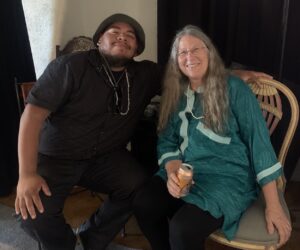Arivaca Pollinator Pathway Project Mural: Ha-Nukkud
The Arivaca Pollinator Pathway Project Mural is titled Ha-Nukkud, which means “to protect” in the Tohono O’odham language. The mural is a collaboration between Tohono O’odham artist Paul ‘Nox’ Pablo and a steering committee of Arivaca community members, including youth from the Arivaca Library Teen Advisory Board (TAB).
The three sides of the building inspired the design of a habitat depicted at three different times of day: the bright sun of afternoon, the glow of sunset, and a moonlit night. Each time of day and night features endangered and threatened species that are native to the Arivaca area and the nearby lands of the Tohono O’odham Nation.

Afternoon: Monarch Butterfly drinking nectar from a native perennial sunflower species with a Monarch caterpillar chrysalis hanging from a leaf on a native milkweed plant below, and

Sunset: Bees, butterflies, hummingbirds, and bats hovering around a giant Saguaro-blossom-shaped sunset;

Moonlit Night: The Lesser Long-nosed Bat pollinating a Saguaro blossom, with a Cactus Ferruginous Pygmy-Owl peering out from a nesting cavity in the Saguaro’s trunk.
The featured species also have special meaning in Tohono O’odham legends and winter storytelling traditions. Tohono O’odham consider Saguaro cacti to be tribal members, and their fruit has been an important traditional source of food and drink for centuries. Lesser Long-nosed Bats (and other nectar-eating bats) are the Saguaros’ main pollinators, and the Cactus Ferruginous Pygmy-Owl nests primarily in abandoned woodpecker cavities within Saguaros. Hummingbirds and Monarch butterflies are both considered to be spiritual messengers. Mesquite trees and Ocotillo shrubs provide materials for tools, shelter, and more.
One of the unique features of the mural is that it is only be able to be viewed in its entirety by “traveling” around the three sides of the building with a close view of the art, rather than viewing the mural as a whole from a distance. This experience creates a subtext in the mural of the importance of free movement and migration to all endangered and threatened species, and to human beings too. Because the building also has a relatively low profile, the mural is nestled into the landscape rather than towering over it, and enables viewers to feel immersed by the art and its message.
In addition, the traditional Tohono O’odham symbol called “man-in-the-maze” is featured on two of the mural walls, so that the portions create a complete symbol when imagined to be joined together. This symbol of life cycles, choice, and eternal motion place human beings in the habitat also, as we share our journeys with all the other species. Paul chose the words Ha-Nukkud as a reminder of the importance for humans to work together to protect all endangered and threatened species, as well as to protect each other.
The mural was painted from August 30th and September 2nd, 2023 by Paul Pablo during his stay in Arivaca, with some of the steering committee members serving as his assistants. A community celebration was held on September 3rd, 2023 at the Arivaca Dancehall, that included the mural dedication, an educational presentation by staff from the Tohono O’odham Cultural Center and a return of artifacts to the Tohono O’odham that had been found stored inside the Arivaca Dancehall. The grand finale of the day was a lively waila music performance by Gertie and the T.O. Boyz, that got everyone kicking up their heels on the dancefloor!



Finding the Mural
The Mural Location: Arivaca is the oldest, continuously-inhabited town in Arizona, with approx. 600 residents. Many historic buildings remain along “main street” (5th St) and nearby side streets that date back to the 1800s, including the Arivaca Schoolhouse built in 1879.
For hundreds of years, the Arivaca area was a place where indigenous people from the Hohokam and O’odham tribes lived, hunted, and gathered food and supplies. It was part of Mexico until the Gadsden Purchase of 1854, and became a mining and ranching center for settlers from Spain and its colonies, and other European nations.
The town of Arivaca is surrounded by the Buenos Aires National Wildlife Refuge, which includes a desert marsh, creek, Cottonwood and Mesquite forests, and grasslands. It is a home for a wide diversity of wildlife species, from mountain lions and coatimundi to hummingbirds and bats. Several endangered or threatened species, such as the Sonoran Pronghorn, Jaguar, Horned Lizard, Monarch Butterfly, Masked Bobwhite, and Sonoran Desert Tortoise are known to live or migrate through this area.
The Mural Site
The Arivaca Dancehall is a multi-purpose, community-driven space that hosts a variety of events such as music concerts, dance classes, banquets, storytelling events, film screenings, art-making and art exhibitions, celebrations, and educational events. It is located in the heart of Arivaca’s “main street”, in a historic adobe building that was built as a dancehall in 1934 and has recently been completely renovated.
The ESA@50 mural will be painted on three sides of the restroom outbuilding that lies in the center of the dancehall property. Each of the three sides is viewable from one of the main outdoor spaces: an accessiblewalkway, courtyard, or fire pit/recreation area. A Pollinator Pathway Garden filled with small shrubs and perennials also surrounds the outbuilding, and will serve as a colorful, low foreground for the mural art.
Arivaca Dancehall, 17271 W. Fifth St., Arivaca, AZ
